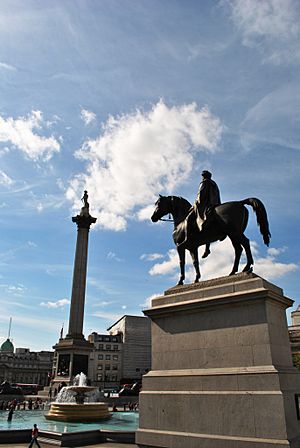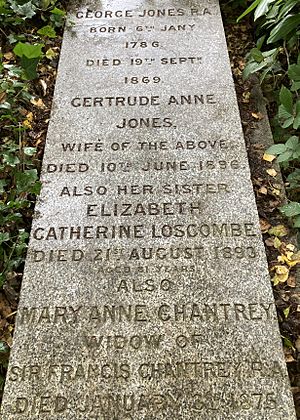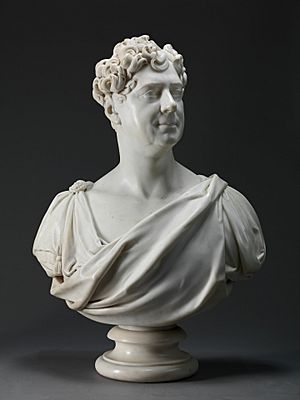Francis Leggatt Chantrey facts for kids
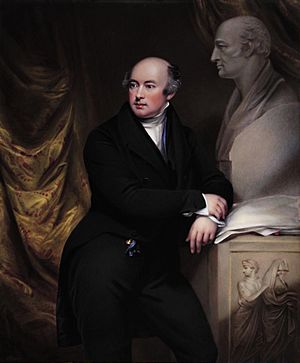
Sir Francis Leggatt Chantrey (born April 7, 1781 – died November 25, 1841) was a famous English sculptor. He became the top portrait sculptor in Regency era Britain, creating many busts (head and shoulder sculptures) and statues of important people of his time. Some of his most well-known works include statues of King George IV in Trafalgar Square, King George III in Guildhall, and George Washington in the Massachusetts State House. He also made four monuments for military heroes in St Paul's Cathedral, London. After he died, he left money to create the Chantrey Bequest. This fund, available from 1878, was used to buy amazing artworks for the nation.
Contents
Life of a Sculptor
Francis Chantrey was born in Jordanthorpe, a small village near Norton (which is now part of Sheffield). His family had a small farm. His father, who also enjoyed carpentry and wood-carving, passed away when Francis was just twelve years old. His mother remarried, and Francis didn't have a clear path for his future.
When he was fifteen, he worked for a grocer in Sheffield. One day, he saw some beautiful wood-carvings in a shop window. This inspired him to ask if he could become an apprentice to a carver instead. He then began working with a woodcarver and gilder named Ramsay in Sheffield.
At Ramsay's house, Francis met John Raphael Smith, a talented artist who was a draughtsman and engraver. Smith saw Francis's artistic talent and gave him painting lessons. Later, Smith helped Francis by introducing him to people who could support his art.
In 1802, Chantrey paid £50 to end his apprenticeship with Ramsay. He immediately opened his own studio in Sheffield as a portrait artist. This allowed him to earn a good income.
For several years, he split his time between Sheffield and London. He studied off and on at the Royal Academy Schools. In the summer of 1802, he traveled to Dublin but became very ill and lost all his hair. He showed his paintings at the Royal Academy for a few years starting in 1804. However, from 1807 onwards, he decided to focus mainly on sculpture.
Later in life, when asked in court if he had ever worked for other sculptors, he famously replied: "No, and what is more, I never had an hour's instruction from any sculptor in my life."
His first known marble bust was of the Rev. James Wilkinson (made between 1805 and 1806) for Sheffield parish church. His first imaginative sculpture, a head of Satan, was shown at the Royal Academy in 1808.
In 1809, a famous architect named Daniel Asher Alexander asked Chantrey to create four large plaster busts of important admirals: Duncan, Howe, Vincent, and Nelson. These were for the Royal Naval Asylum at Greenwich. He received £10 for each. Three of these busts were displayed at the Royal Academy that same year.
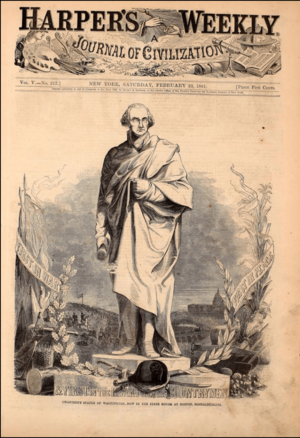
On November 23, 1809, he married his cousin, Mary Ann Wale, at St Mary's Church, Twickenham. By this time, he had settled permanently in London. His wife brought a large sum of money into the marriage, which helped Chantrey pay off his debts. The couple moved into a house at 13 Eccleston Street, Pimlico. He also bought land to build two more houses, a studio, and offices.
In 1811, he showed six busts at the Royal Academy. These included sculptures of John Horne Tooke, a political figure he admired, and his early mentor, John Raphael Smith. Another famous sculptor, Joseph Nollekens, placed Chantrey's bust of Tooke between two of his own. This prominent display greatly helped Chantrey's career. After the exhibition, he received many new commissions. By 1813, he was able to charge a higher price for his busts, and by 1822, he charged even more.
He visited Paris in 1814 and again in 1815 with his wife and friends. They visited the Louvre Museum where he especially admired the works of famous painters like Raphael and Titian. In 1819, he traveled to Italy with the painter John Jackson. In Rome, he met other famous sculptors like Thorvaldsen and Canova, becoming good friends with Canova.
In 1828, Chantrey opened his own foundry (a place where metal is cast) in Eccleston Place, near his home and studio. This allowed him to create large bronze works, including statues of people on horseback.
How Chantrey Worked
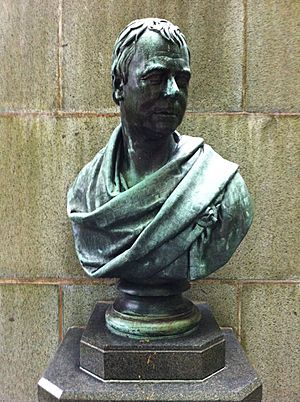
Chantrey had a special way of making his portrait sculptures. First, he would make two life-sized drawings of the person's head: one looking straight ahead and one from the side. He used a tool called a camera lucida to help him. Then, his assistants would create a clay model based on these drawings. Chantrey would then add the final touches to the clay model while the person was sitting for him.
After the clay model was perfect, a plaster cast was made from it. Finally, a marble copy was carved from the plaster cast. His main assistants, Allan Cunningham and Henry Weekes, helped create many of the works that carried Chantrey's name. As he got older and suffered from heart disease, he relied even more on his assistants.
Chantrey's Artistic Style
Chantrey was unusual among the top sculptors of his time because he hadn't visited Italy when he was young and still learning. A writer in Blackwood's Edinburgh Magazine in 1820 believed Chantrey helped free English sculpture from foreign influences. They wrote that he brought English sculpture back to its "natural and original character" and from "cold and conceited fiction to tender and elevated truth."
More recently, art historian Margaret Whinney wrote that Chantrey "had a great gift for characterisation." This means he was very good at capturing the unique personality of the people he sculpted. People also admired his ability to make the sculptures look like soft, real skin. She noted that while he sometimes had to create classical-looking works because it was popular, his true talent shone in works that combined simple, classic shapes with a very natural look.
Famous Works
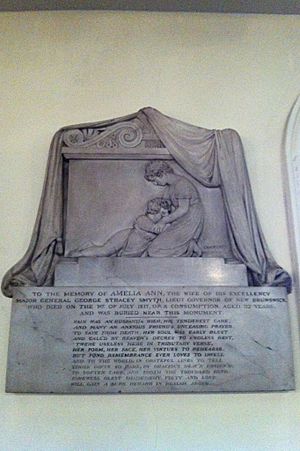
Chantrey was a very busy sculptor. He created many busts and reliefs (sculptures that stick out from a flat surface). He also made three statues of people on horseback, 18 standing statues, 18 seated statues, and 14 reclining figures.
Some of his most famous works include:
- Statues of King George III in the Guildhall, London.
- A statue of George Washington in the State-house at Boston, Massachusetts.
- A bronze statue of King George IV in Brighton.
- A bronze statue of William Pitt the Younger in Hanover Square, London.
- Statues of James Watt in Westminster Abbey and Greenock.
- A statue of John Dalton in Manchester Town Hall.
- Statues of William Roscoe and George Canning in Liverpool.
He made a bronze statue of Sir Thomas Munro for Madras (now Chennai, India) and another of King George IV. The King himself asked for this statue to be placed on top of the Marble Arch in front of Buckingham Palace. However, it ended up in Trafalgar Square. The horses in these two statues are exactly the same! A third equestrian statue, of the Duke of Wellington, was finished after Chantrey's death. It stands in front of the Royal Exchange in London.
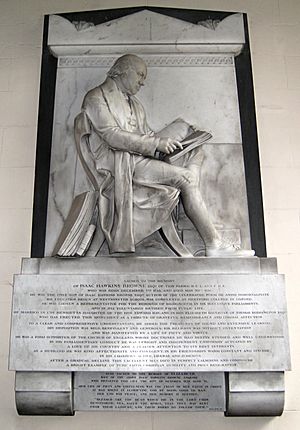

Chantrey also created four monuments for military heroes in St Paul's Cathedral. These honor Major-General Daniel Hoghton, Major-General Bowes, Colonel Henry Cadogan, and (in one monument) Major-Generals Gore and Skerrett. He also made memorials for Sir James Brisbane in St James' Church, Sydney and for Reginald Heber in Calcutta. A copy of the Heber monument was later made for St Paul's Cathedral in London. Other great examples of his church monuments include those for the Earl of Farnham (1826) in Urney Parish Church, Cavan, and Mary Anne Boulton (1834) in Great Tew. In Snaith church, there is a notable monument to Viscount Downe by Chantrey.
One of his most famous works is The Sleeping Children. This monument shows two young sisters from the Robinson family, asleep in each other's arms. The younger sister holds a bunch of snowdrops. This sculpture gained a lot of attention when it was shown at the Royal Academy in 1817, before it was placed in Lichfield Cathedral.
The Derby Museum has a unique bust of William Strutt.
Honours and Recognition
Chantrey was recognized for his amazing talent. He was chosen as an Associate of the Royal Academy in 1816 and became a full Academician in 1818. In 1822, a place called Chantry Island in Ontario was named after him. He received special degrees from the Cambridge and Oxford universities. In 1835, he was knighted, which means he received the title "Sir."
Death
Sir Francis Chantrey passed away suddenly at his home in Eccleston Street, Pimlico, London, on November 25, 1841. He had suffered from heart disease for several years. He was buried in a tomb built by his assistant James Heffernan in the churchyard of his hometown, Norton in Derbyshire (now part of Sheffield).
The Chantrey Bequest
Sir Francis Chantrey had no children. In his will, dated December 31, 1840, he left most of his personal wealth to a special trust. This money would become available after his wife passed away or remarried. The money was given to the president and trustees of the Royal Academy. The purpose was to encourage British painting and sculpture. The income from the fund was to be used to buy "works of fine art of the highest merit."
The fund could save up money for up to five years. It could buy works by British or foreign artists, whether they were alive or had passed away. However, the artworks had to be completely made in Great Britain, and the artists had to live there while creating them. The prices paid for the art were to be "generous." The will also stated that sympathy for an artist or their family should not influence which works were chosen. Works were to be bought only based on their artistic quality. No new commissions or orders could be given; the artworks had to be finished before they were purchased.
Chantrey hoped that the government or the country would provide a suitable gallery to display these artworks. He also set aside money for the president and secretary of the Royal Academy to manage the will's instructions.
Lady Chantrey died in 1875 and was buried in Highgate Cemetery. Two years later, the fund became available to buy paintings and sculptures. The fund had a large amount of money, providing a good annual income.
At first, the artworks bought with the fund were shown at the Victoria and Albert Museum. But in 1898, the Royal Academy arranged for the collection to be moved to the National Gallery of British Art, which was built by Sir Henry Tate at Millbank. It was agreed that the Tate Gallery (now Tate Britain) would be its future home.
By the end of 1905, many works had been bought, mostly from living artists. The Chantrey Bequest was the main way the collection at Tate Britain grew until the 1920s, and it is still active today, continuing to support British art.
Images for kids
-
John Dalton statue at Manchester Town Hall


